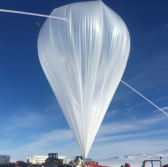Orbital ATK  supported NASA‘s scientific balloon team in the launch of five scientific balloon flights that carried instruments and payloads developed to provide scientific data on cosmic ray particles and the life cycle of the interstellar medium.
 supported NASA‘s scientific balloon team in the launch of five scientific balloon flights that carried instruments and payloads developed to provide scientific data on cosmic ray particles and the life cycle of the interstellar medium.
Orbital ATK said Monday the balloons launched as part of the NASA Antarctica Long Duration Balloon Flight Campaign and the five flights in Antarctica that stayed airborne for six days set a new flight record for the space agency’s scientific balloon team.
The National Science Foundation‘s United States Antarctic Program supported the launch of the five payloads from Antarctica’s Ross Ice Shelf.
The company oversees NASA’s Columbia Scientific Balloon Facility under a previously awarded Balloon Operations Contract that covers engineering, field operations and mission planning services.
Payloads on the five scientific balloon flights include:
- Boron and Carbon Cosmic rays in the Upper Stratosphere, University of Maryland
- Antarctic Impulsive Transient Antenna, University of Hawaii
- Stratospheric Terahertz Observatory, University of Arizona
- High Altitude Radio Frequency Surface Reflectivity Calibration #1 and #2 payloads, University of Kansas
John Pullen, vice president and general manager of the technical services division at Orbital ATK’s space systems business, said the five balloon launches demonstrates the group’s commitment to provide support on each mission for the company’s clients.
“We congratulate NASA for this historic campaign which will help maintain the Wallops Flight Facility’s position as the world leader in scientific ballooning operations.”




